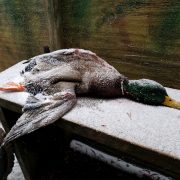Posts
Staying Warm (without products)
/in Deer Hunting, Duck Hunting, Goose Hunting /by Brian BurressHunters are known for their propensity to venture outdoors in the coldest weather. When you ask
someone who do esn’t hunt to come with you, one of the first things they mention is “no thanks, I don’t like the cold.” There are a variety of products on the market to help you keep warm, but what can you do to stay warm without purchasing a case of hand warmers? Here are a few techniques to use to keep warm during those late-season cold weather hunts.
esn’t hunt to come with you, one of the first things they mention is “no thanks, I don’t like the cold.” There are a variety of products on the market to help you keep warm, but what can you do to stay warm without purchasing a case of hand warmers? Here are a few techniques to use to keep warm during those late-season cold weather hunts.
 esn’t hunt to come with you, one of the first things they mention is “no thanks, I don’t like the cold.” There are a variety of products on the market to help you keep warm, but what can you do to stay warm without purchasing a case of hand warmers? Here are a few techniques to use to keep warm during those late-season cold weather hunts.
esn’t hunt to come with you, one of the first things they mention is “no thanks, I don’t like the cold.” There are a variety of products on the market to help you keep warm, but what can you do to stay warm without purchasing a case of hand warmers? Here are a few techniques to use to keep warm during those late-season cold weather hunts.
Hand Not In Glove
Gloves are good when your hands must be out and active, but when your hands are still, gloves will get cold. The wind will sap the heat out of them, and idle hands inside gloves will get cold. If you’re going to be sitting still, take the gloves off and put your hands in your pockets or inside your waders. Your core body heat will help heat the pocket, and your hands will stay warmer than if they were in gloves.
Warmth Funnel
Body heat escapes upwards, so layer clothing appropriately. Have your pants leg over the outside of your boots, so the warmth from your feet goes inside your pants instead of out into the air. Have a shirt over the outside of your pants, so warmth continues up your body. If you have a hood, you’ll be warmer wearing it so the warmth from your torso will filter around your head before escaping. If you wear a full facemask, try to tuck your shirt collar inside the bottom so warmth continues flowing upward. Your goal is to create a funnel that keeps warmth inside your clothing and around your body as much as possible.
Cold Feet
Some people stack three or four pairs of socks on top of each other, then jam their foot inside boots with 800 grams of Thinsulate. With that much layering, multiple things can happen to cause your feet to get cold. First, your feet will get too hot and sweat, creating a moisture layer which sucks heat away from your feet. Second, blood may not be able to flow readily around your feet, making it hard to keep them warm. Last, if you can’t wiggle your toes and flex your feet, blood flow will slow down, and your feet will get cold.
Definitely wear warm socks and boots, but be reasonable. You need to be able to wiggle your toes and flex your ankles. Movement will keep the blood pumping, which generates warmth for your feet. So, hold back on the layering and focus more on the wiggling.
Keep the Flow Going
Being still is important to success when hunting, but you need to be aware of blood flow. If you are sitting still but your leg is falling asleep, then your blood is not able to flow appropriately through your leg. This means your leg will get cold faster than if you had proper blood flow. Stay aware of your blood flow while trying to keep still. When setting up, pay attention to pressure points that might be restricting your veins. Don’t stand or sit in a way that constricts blood flow for too long, a little movement throughout the day is worth it to keep you warmer. Don’t wear clothing that is too tight and is pinching your veins. If you stay warm and comfortable, it will be much easier to hunt longer and stay more still when it counts.
Preserve the Core
Your body is very intelligent at managing heat for survival. This is why your fingers, toes, and nose are always the first parts of your body to get cold. We’ve evolved such that our body places the highest priority on keeping our core torso warm. When exposed to cold weather, our body naturally begins pulling blood flow from our extremities in order to maintain our core temperature.
With this in mind, it’s important to keep your core warm in order to keep your fingers warm. Layer up with a coat, vest, or thermal clothing on your core body. This will help the core retain warmth, freeing up your natural body resources to keep your extremities warm. To put it simply, if you want warm fingers and toes, focus first on a warm belly and chest.
Elevate Your Bottom
On those late season cold weather hunts, often times the ground is extremely cold and/or frozen. The cold ground is a huge heat sink and will pull body heat from you very quickly. If you’re hunting on the ground, insulate yourself from the ground as best you can. Bring a cushion or an extra jacket to sit on, or arrange a couple of logs as a seat. Anything that keeps your bottom from direct contact with the ground will keep the ground from sapping your body of warmth.
Halt the Breeze
Much like the ground, the wind will sap your body heat away quickly. Getting out of the wind is vital to keeping warm during cold weather hunts. Get behind a tree, on the lee side of a hill, or move brush accordingly to shelter yourself. Oftentimes it’s best for hunters to face into the wind, making it hard to stay completely sheltered. Still, getting as much of your body out of the wind as possible will help retain body heat.
Conclusion
If you keep yourself warm, you’ll stay comfortable. Being comfortable means you’ll be able to sit more still and stay hunting longer. You can use plenty of commercial products for warmth, but they all have their own limiting factors. Remember these techniques, and you can manage your body during cold weather hunts to maximize the retention of your naturally-generated body heat.


